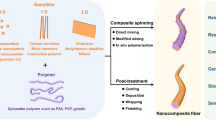Abstract
A series of regular and tunable rigid–flexible crosslinking networks have been prepared to investigate shape memory effects. The tunable rigid–flexible epoxy resins (TRFEPs) were synthesized by ultraviolet light thiol–ene click chemistry. The FTIR and 1H NMR measurements indicated that TRFEPs were successfully synthesized. The thermal, thermomechanical, mechanical, and shape memory properties of all regular crosslinking networks were systematically investigated by DSC, DMA, tensile test, and quantitative shape memory evaluation method, respectively. It was found that with the flexibility of the crosslinking networks increasing, T gDSC, T gDMA, E′ (25 °C), shape recovery rate, and tensile stress decreased and elongation at break increased. Besides, DMA measurements showed that the regular network had relatively narrow glass transition zone. The tunable rigid–flexible crosslinking networks exhibited a ductile plastic fracture feature with the occurrence of yielding phenomenon and had relatively high tensile strength (20–44 MPa). Quantitative shape memory evaluation disclosed that the regular crosslinking networks exhibited excellent shape memory performance with high shape memory fixity (>97 %) and shape memory recovery (>99 %). Especially, it was discovered that the regularity of network was the primary effect factor and the flexibility was the subordinate effect factor on the shape recovery rate. Excellent shape memory properties and great mechanical properties make the materials good candidates for space deployable structure materials and wide applications in other important fields.











Similar content being viewed by others
References
Zhao Q, Qi HJ, Xie T (2014) Recent progress in shape memory polymer: new behavior, enabling materials, and mechanistic understanding. Prog Polym Sci 49–50:79–120
Hager MD, Bode S, Weber C, Schubert US (2015) Shape memory polymers: past, present and future developments. Prog Polym Sci 49:3–33
Shi Y, Yoonessi M, Weiss RA (2013) High temperature shape memory polymers. Macromolecules 46:4160–4167
Wang R, Xie T (2010) Shape memory—and hydrogen bonding-based strong reversible adhesive system. Langmuir 26:2999–3002
Xiao X, Kong D, Qiu X et al (2015) Shape-memory polymers with adjustable high glass transition temperatures. Macromolecules 48:3582–3589
Kumpfer JR, Rowan SJ (2011) Thermo-, photo-, and chemo-responsive shape-memory properties from photo-cross-linked metallo-supramolecular polymers. J Am Chem Soc 133:12866–12874
Wang K, Jia Y-G, Zhu XX (2015) Biocompound-based multiple shape memory polymers reinforced by photo-cross-linking. ACS Biomater Sci Eng 1:855–863
Song Q, Chen H, Zhou S et al (2016) Thermo-and pH-sensitive shape memory polyurethane containing carboxyl groups. Polym Chem 7:1739–1746
Lu H, Lei M, Leng J (2014) Significantly improving electro-activated shape recovery performance of shape memory nanocomposite by self-assembled carbon nanofiber and hexagonal boron nitride. J Appl Polym Sci 131:1–7
Xiao Y, Zhou S, Wang L, Gong T (2010) Electro-active shape memory properties of poly (ε-caprolactone)/functionalized multiwalled carbon nanotube nanocomposite. ACS Appl Mater Interfaces 2:3506–3514
Calvo-Correas T, Gabilondo N, Alonso-Varona A et al (2016) Shape-memory properties of crosslinked biobased polyurethanes. Eur Polym J 78:253–263
Guo C, Zhou L, Lv J (2013) Effects of expandable graphite and modified ammonium polyphosphate on the flame-retardant and mechanical properties of wood flour-polypropylene composites. Polym Polym Compos 21:449–456
Raasch J, Ivey M, Aldrich D et al (2015) Characterization of polyurethane shape memory polymer processed by material extrusion additive manufacturing. Addit Manuf 8:132–141
Zhang Z, He Z, Yang J et al (2016) Crystallization controlled shape memory behaviors of dynamically vulcanized poly (l-lactide)/poly (ethylene vinyl acetate) blends. Polym Test 51:82–92
Garle A, Kong S, Ojha U, Budhlall BM (2012) Thermoresponsive semicrystalline poly (ε-caprolactone) networks: exploiting cross-linking with cinnamoyl moieties to design polymers with tunable shape memory. ACS Appl Mater Interfaces 4:645–657
Lewis CL, Meng Y, Anthamatten M (2015) Well-defined shape-memory networks with high elastic energy capacity. Macromolecules 48:4918–4926
Kunzelman J, Chung T, Mather PT, Weder C (2008) Shape memory polymers with built-in threshold temperature sensors. J Mater Chem 18:1082–1086
Hearon K, Wierzbicki MA, Nash LD et al (2015) A Processable shape memory polymer system for biomedical applications. Adv Healthc Mater 4:1386–1398
Small W, Singhal P, Wilson TS, Maitland DJ (2010) Biomedical applications of thermally activated shape memory polymers. J Mater Chem 20:3356–3366
Liu Y, Du H, Liu L, Leng J (2014) Shape memory polymers and their composites in aerospace applications: a review. Smart Mater Struct 23:23001–23022
Santhosh Kumar KS, Biju R, Reghunadhan Nair CP (2013) Progress in shape memory epoxy resins. React Funct Polym 73:421–430
Feldkamp DM, Rousseau IA (2010) Effect of the deformation temperature on the shape-memory behavior of epoxy networks. Macromol Mater Eng 295:726–734
Zheng N, Fang G, Cao Z et al (2015) High strain epoxy shape memory polymer. Polym Chem 6:3046–3053
Santiago D, Fabregat-Sanjuan A, Ferrando F, De la Flor S (2016) Recovery stress and work output in hyperbranched poly (ethyleneimine)-modified shape-memory epoxy polymers. J Polym Sci Part B: Polym Phys 54:1002–1013
Liu Y, Zhao J, Zhao L et al (2016) High performance shape memory epoxy/carbon nanotube nanocomposites. ACS Appl Mater Interfaces 8:311–320
Dondoni A, Marra A (2012) Recent applications of thiol–ene coupling as a click process for glycoconjugation. Chem Soc Rev 41:573–586
Hoyle CE, Bowman CN (2010) Thiol-ene click chemistry. Angew Chemie-Int Ed 49:1540–1573
Hoyle CE, Lowe AB, Bowman CN (2010) Thiol-click chemistry: a multifaceted toolbox for small molecule and polymer synthesis. Chem Soc Rev 39:1355–1387
Sen MY, Puskas JE (2008) Green polymer chemistry: telechelic poly (ethylene glycol)s via enzymatic catalysis. Am Chem Soc Polym Prepr Div Polym Chem 49:487–488
Acknowledgements
The authors gratefully acknowledge the financial support from the National Natural Science Foundation of China under Grant No. 21476013.
Author information
Authors and Affiliations
Corresponding authors
Rights and permissions
About this article
Cite this article
Zou, Q., Ba, L., Tan, X. et al. Tunable shape memory properties of rigid–flexible epoxy networks. J Mater Sci 51, 10596–10607 (2016). https://doi.org/10.1007/s10853-016-0281-1
Received:
Accepted:
Published:
Issue Date:
DOI: https://doi.org/10.1007/s10853-016-0281-1




